Conservatoire de Paris
The Conservatoire de Paris (pronounced [kɔ̃.sɛʁ.va.twaʁ də pa.ʁi]), also known as the Paris Conservatory, is a college of music and dance founded in 1795. Officially known as the Conservatoire National Supérieur de Musique et de Danse de Paris (CNSMDP), it is situated in the avenue Jean Jaurès in the 19th arrondissement of Paris, France. The Conservatoire offers instruction in music and dance, drawing on the traditions of the "French School". Formerly the conservatory also included drama, but in 1946 that division was moved into a separate school, the Conservatoire National Supérieur d'Art Dramatique (CNSAD), for acting, theatre and drama. Today the conservatories operate under the auspices of the Ministry of Culture and Communication and are associate members of PSL Research University.[2] The CNSMDP is also associated with the Conservatoire National Supérieur de Musique et de Danse de Lyon (CNSMDL).
Conservatoire national supérieur de musique et de danse de Paris (CNSDMP) | |
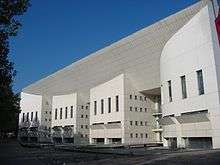 Current home of the CNSMDP | |
| Type | Grande école |
|---|---|
| Established | 1795 |
| Affiliation | PSL Research University |
| Director | Émilie Delorme[1] |
| Address | 209 avenue Jean-Jaurès , Paris , , 75019 , France |
| Campus | Urban |
| Website | www |
History
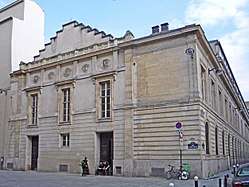
École Royale de Chant
On 3 December 1783 Papillon de la Ferté, intendant of the Menus-Plaisirs du Roi, proposed that Niccolò Piccinni should be appointed director of a future École Royale de Chant (Royal School of Singing). The school was instituted by a decree of 3 January 1784 and opened on 1 April with the composer François-Joseph Gossec as the provisional director. Piccinni refused the directorship, but did join the faculty as a professor of singing. The new school was located in buildings adjacent to the Hôtel des Menus-Plaisirs at the junction of the rue Bergère and the rue du Faubourg Poissonnière.[3][4] In June, a class in dramatic declamation was added, and the name was modified to École Royale de Chant et de Déclamation.[5]
Institut National de Musique
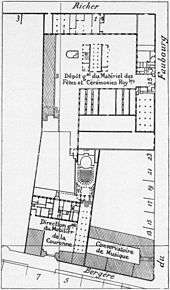
In 1792, Bernard Sarrette created the École Gratuite de la Garde Nationale, which in the following year became the Institut National de Musique. The latter was also installed in the facilities of the former Menus-Plaisirs on the rue Bergère[3] and was responsible for the training of musicians for the National Guard bands, which were in great demand for the enormous, popular outdoor gatherings put on by the revolutionary government after the Reign of Terror.[4]
Founding of the Conservatoire
On 3 August 1795, the government combined the École Royale with the Institut National de Musique, creating the Conservatoire de Musique under the direction of Sarrette. The combined organization remained in the facilities on the rue Bergère. The first 351 pupils commenced their studies in October 1796.[4][6]
By 1800, the staff of the Conservatory included some of the most important names in music in Paris, including, besides Gossec, the composers Luigi Cherubini, Jean-François Le Sueur, Étienne Méhul, and Pierre-Alexandre Monsigny, as well as the violinists Pierre Baillot, Rodolphe Kreutzer, and Pierre Rode.[4]
Salle des Concerts du Conservatoire
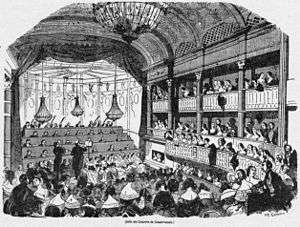
A concert hall, designed by the architect François-Jacques Delannoy,[7] was inaugurated on 7 July 1811.[8] The hall, which still exists today, was in the shape of a U (with the orchestra at the straight end). It held an audience of 1055.[9] The acoustics were generally regarded as superb. The French composer and conductor Antoine Elwart described it as the Stradivarius of concert halls.[10]
In 1828 François Habeneck, a professor of violin and head of the Conservatory's orchestra, founded the Société des Concerts du Conservatoire (forerunner of the Orchestre de Paris). The Society held concerts in the hall almost continuously until 1945, when it moved to the Théâtre des Champs-Élysées.[11] The French composer Hector Berlioz premiered his Symphonie Fantastique in the conservatory's hall on 5 December 1830 with an orchestra of more than a hundred players.[8]
Library
.jpg)
The original library was created by Sarrette in 1801.[12] After the construction of the concert hall, the library moved to a large room above the entrance vestibule.[13] In the 1830s, Berlioz became a part-time curator in the Conservatory library and was the librarian from 1852 until his death in 1869, but never held a teaching position. He was succeeded as librarian by Félicien David.[4]
Bourbon Restoration
Sarrette was dismissed on 28 December 1814, after the Bourbon Restoration, but was reinstated on 26 May 1815, after Napoleon's return to power during the Hundred Days. However, after Napoleon's fall, Sarrette was finally compelled to retire on 17 November.[12] The school was closed in the first two years of the Bourbon Restoration, during the reign of Louis XVIII, but reopened in April 1816 as the École Royale de Musique, with François-Louis Perne as its director.[4] In 1819, François Benoist was appointed professor of organ.[9]
Probably the best known director in the 19th century was Luigi Cherubini, who took over on 1 April 1822 and remained in charge until 8 February 1842. Cherubini maintained high standards and his staff included teachers such as François-Joseph Fétis, Habeneck, Fromental Halévy, Le Sueur, Ferdinando Paer, and Anton Reicha.[4]
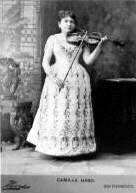
Cherubini was succeeded by Daniel-François-Esprit Auber in 1842. Under Auber, composition teachers included Adolphe Adam, Halévy, and Ambroise Thomas; piano teachers, Louise Farrenc, Henri Herz, and Antoine François Marmontel; violin teachers, Jean-Delphin Alard and Charles Dancla; and cello teachers, Pierre Chevillard and Auguste Franchomme.[4]
In 1852, Camille Urso, who studied with Lambert Massart, became the first female student to win a prize on violin.[14]
Instrument museum
The Conservatory Instrument Museum, founded in 1861, was formed from the instrument collection of Louis Clapisson.[4][15] The French music historian Gustave Chouquet became the curator of the museum in 1871 and did much to expand and upgrade the collection.[15]
Franco-Prussian War and the Third Republic
In the Franco-Prussian War, during the siege of Paris (September 1870 – January 1871), the Conservatory was used as a hospital. On 13 May 1871, the day after Auber's death, the leaders of the Paris Commune appointed Francisco Salvador-Daniel as the director – however Daniel was shot and killed ten days later by the troops of the French Army. He was replaced by Ambroise Thomas, who remained in the post until 1896. Thomas's rather conservative directorship was vigorously criticized by many of the students, notably Claude Debussy.[4]
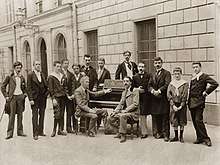
During this period César Franck was ostensibly the organ teacher, but was actually giving classes in composition. His classes were attended by several students who were later to become important composers, including Ernest Chausson, Guy Ropartz, Guillaume Lekeu, Charles Bordes, and Vincent d'Indy.[4]
Théodore Dubois succeeded Thomas after the latter's death in 1896. Professors included Charles-Marie Widor, Gabriel Fauré, and Charles Lenepveu for composition, Alexandre Guilmant for organ, Paul Taffanel for flute, and Louis Diémer for piano.[4]
Gabriel Fauré
.jpg)
Lenepveu had been expected to succeed Dubois as director, but after the "Affaire Ravel" in 1905, Ravel's teacher Gabriel Fauré became director. Le Courrier Musical (15 June 1905) wrote: "Gabriel Fauré is an independent thinker: that is to say, there is much we can expect from him, and it is with joy that we welcome his nomination."[16]
Fauré appointed forward-thinking representatives (such as Debussy, Paul Dukas, and André Messager) to the governing council, loosened restrictions on repertoire, and added conducting and music history to the courses of study. Widor's composition students during this period included Darius Milhaud, Arthur Honegger, and Germaine Tailleferre. Other students included Lili Boulanger and Nadia Boulanger. New to the staff were Alfred Cortot for piano and Eugène Gigout for organ.[4]
The modern era
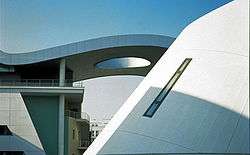
The Conservatory moved to facilities at 14 rue de Madrid in 1911.[4]
Henri Rabaud succeeded Fauré in 1920 and served until 1941. Notable students were Olivier Messiaen, Jean Langlais, and Jehan Alain. Staff included Dukas and Jean Roger-Ducasse for composition, Marcel Dupré for organ, Marcel Moyse for flute, and Claire Croiza for singing.[4]
Claude Delvincourt was director from 1941 until his tragic death in an automobile accident in 1954. Delvincourt was a progressive administrator, adding classes in harpsichord, saxophone, percussion, and the Ondes Martenot. Staff included Milhaud for composition and Messiaen for analysis and aesthetics. In 1946, the dramatic arts were transferred to a separate institution (CNSAD). Delvincourt was succeeded by Dupré in 1954, Raymond Loucheur in 1956, Raymond Gallois-Montbrun in 1962, Marc Bleuse in 1984, and Alain Louvier in 1986. Plans to move the Conservatory of Music and Dance to more modern facilities in the Parc de la Villette were initiated under Bleuse and completed under Louvier. It opened as part of the Cité de la Musique in September 1990.[4]
After over two centuries of male directors, Émilie Delorme, for a decade director of the European Academy of Music (French: Académie européenne de musique) at the Aix-en-Provence Festival, was appointed as the Conservatoire's first woman director on 14 December 2019.[1][17]
Currently, the conservatories train more than 1,200 students in structured programs, with 350 professors in nine departments.
CNSAD
The Conservatoire National Supérieur d'Art Dramatique (CNSAD) (National Superior Conservatory of the Dramatic Arts) is the conservatory for acting, drama, and theatre, known by its acronym CNSAD. It is located in the original historic building of the Conservatoire de Paris on the rue du Conservatoire at rue Sainte-Cécile in the 9th arrondissement of Paris. Free public performances by students at the CNSAD are given frequently in the Conservatoire's theatre.
CNSMDP
The Conservatoire National Supérieur de Musique et de Danse de Paris (CNSMDP) (National Superior Conservatory of Paris for Music and Dance) is a separate conservatory for music and dance. The French government built its new campus in the 19th arrondissement of Paris. It was designed by Christian de Portzamparc.
The organ on site was built in 1991 by the Austrian Rieger Orgelbau firm. It has 53 stops on 3 manuals and pedals. A larger organ of over 7,000 pipes with 91 stops was made in 2015 by the same company for the symphony hall of the nearby Philharmonie de Paris.
Students and former faculty
- A listing of former students can be found at List of former students of the Conservatoire de Paris
- A listing of former teachers can be found at List of former teachers at the Conservatoire de Paris
Notes
- Emilie Delorme, première femme nommée à la tête du Conservatoire de Paris [Emilie Delorme, first woman nominated as head of the Conservatoire de Pari], Le Monde (in French) 14 December 2019. Archived from the original on 14 December 2019. Retrieved 14 December 2019.
- "Associés", PSL website.
- Prod'homme & Crauzat 1929, pp. 67–74.
- Simeone 2000, pp. 214–217, "Conservatoire de Musique".
- Chouquet 1900, p. 391.
- Pierre 1895, pp. 179–182.
- Brault & Du Bois 1893, p. 53.
- Simeone 2000, pp. 183–184, "Salle de l'Ancien Conservatoire".
- Charlton et al 2001.
- Holoman 2004, p. 72.
- Holoman 2004, pp. 3, 85; Pierre 1900, p. 771.
- Chouquet 1900, p. 392.
- Prod'homme & Crauzat 1929, pp. 120–121.
- Le Ménestrel (2 August 1903), p. 243.
- Fétis 1878, vol. 1, pp. 181–182, "Chouquet (Adolphe-Gustave)".
- Quoted and translated by Simeone 2000, p. 216.
- "The Académie – A Thousand and One Stories for a Twenty-Year Adventure" at the Aix-en-Provence Festival website.
Bibliography
- Brault, Élie; Du Bois, Alexandre, editor (1893). Les Architectes par leurs œuvres, volume 3 (at HathiTrust). Paris: H. Laurens. Notice bibliographique, BnF.
- Charlton, David; Trevitt, John; Gosselin, Guy (2001). "Paris. VI. 1789–1870" in The New Grove Dictionary of Music and Musicians, 2nd edition, edited by Stanley Sadie. London: Macmillan. ISBN 9781561592395 (hardcover). OCLC 419285866 (eBook).
- Chouquet, Gustave (1900). "Conservatoire de Musique" in A Dictionary of Music and Musicians, edited by George Grove. London: Macmillan. Copy at Wikisource.
- Fétis, François-Joseph (1878). Biographie universelle des musiciens, supplement in two volumes by Arthur Pougin. Paris: Didot. Vols. 1 and 2 at Google Books.
- Holoman, D. Kern (2004). The Société des Concerts du Conservatoire, 1828–1967. Berkeley: University of California Press. ISBN 9780520236646.
- Pierre, Constant, editor (1895). B. Sarrette et les origines du Conservatoire national de musique et de déclamation. Paris: Delalain Frères. Copy at Google Books.
- Pierre, Constant, editor (1900). Le Conservatoire national de musique et de déclamation. Documents historiques et administratifs. Paris: Imprimerie Nationale. 1031 pages. View at Google Books.
- Prod'homme, Jacques-Gabriel; Crauzat, E. de (1929). Les Menus Plaisirs du Roi. L'école royale et le Conservatoire de musique. Paris: Delagrave. OCLC 842136603.
- Simeone, Nigel (2000). Paris – A Musical Gazetteer. New Haven: Yale University Press. ISBN 9780300080537.